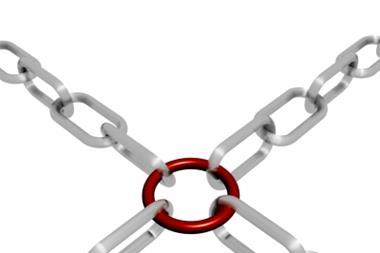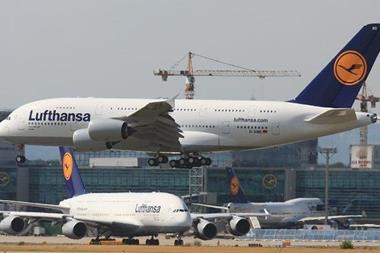A forecast boom in the aerospace industry poses unprecedented supply chain problems

Part of a manufacturing risk series supported by FM Global
Reduced to its individual parts, a commercial airliner is the world’s most complex and biggest jigsaw. It is a compendium of about four million items of varying sizes that, by a remarkable feat of manufacturing and logistics, arrive on the assembly line in time to play their part in the construction of the end product.
And since there are no vertical manufacturers in an industry that relies on myriad technologies and sciences, about 75% of these parts are produced by external suppliers. The aircraft manufacturer’s supply chain has long been acknowledged as the most challenging of any industry – and it’s about to get even more daunting with an unprecedented ramp-up of production.
Boeing’s most recent market outlook anticipates an extra 36,770 aircraft taking to the skies in the next 20 years, equivalent to a doubling of the current global fleet. Late last year Boeing estimated that China alone would buy more than 6,000 of its mainly single-aisle commercial aircraft between now and 2035.
According to an analysis by global consultancy PwC, the pressure is on the aerospace sector to deliver the equivalent of 200 additional single-isle aircraft every year. And because much of that growth will inevitably be borne by a long tail of suppliers, it will place severe strain on their capacity and velocity.
Picture of volatility
Yet, as sources told StrategicRISK, the mooted increase in production tells only half the story. First, the increasing variation that airlines now demand within the same basic model of aircraft adds further complexity and risk for suppliers. Second, airlines often wait until the last possible date to decide on their configurations – another level of pressure that rolls right down the supply line. And third, so-called sturdy military orders that usually require little or no variation are decreasing relative to volatile commercial demand.
Even more sobering, nearly all companies in the supply chain are up to full capacity even before the ramp-up and have little room in which to manoeuvre. “They already have several years of production in their books,” says one source.
It’s not just the industry giants such as Boeing and Airbus – the original equipment manufacturer – that are faced with the task of developing supply chains sufficiently robust to handle future growth; it is the support sector as well.
According to International Data Corporation Manufacturing Insights, in order to keep pace with the servicing of new aircraft, the maintenance, repair and overhaul (MRO) sector will have to develop and nurture partnerships with new suppliers and logistics providers in double-quick time – particularly in emerging markets, where demand for their services is rising but where they do not yet have much experience.
The consultancy warns that greater globalisation introduces challenging factors for MROs to manage in the form of “inexperienced workforces, immature logistics networks and regulatory oversight challenges”. They will need help from regional partners such as logistics providers to help them with local risks and compliance demands as well as workflow dynamics.
Consolidation
At this stage, there seem to be more problems than answers. But some industry veterans say a certain amount of consolidation will be inevitable as suppliers merge, possibly for financial reasons.
There are fears that a significant number of suppliers to major aircraft makers – commercial and military – have underinvested in new capacity and technology. As PwC adds, supply chain risk is a much bigger issue than product quality.
“When PwC looked at 12 key commercial and defence aerospace growth programmes, it found that one-fifth of suppliers are not financially ready to support the high ramp-up [that lies] ahead of them,” the consultant reported. “At a time when banking and market uncertainties remain high, the importance of checks on financial as well as operational and capacity vulnerabilities can’t be underestimated.”
Drastic solutions may be necessary to preserve the integrity of the supply chain. For instance, in late 2011 EADS (now named Airbus Group) was forced to take a majority stake in Germany’s PFW Aerospace, which was in the throes of a liquidity crisis.
Insiders say similar strategic M&A deals are likely to happen again. “In order to meet growth pressures, some players will choose to purchase smaller companies and integrate them into their own business,” says one source. “These companies can then be controlled more efficiently as part of a bigger operation.”
In the same vein, accountancy giant BDO’s head of manufacturing Tom Lawton warned recently: “Aggressive ramp-up rates are putting [aerospace] suppliers under enormous pressure and companies in the supply chain will need scale and resources to absorb this pressure over the longer term.”
If companies want to stay in the game, he says, they must be prepared to invest in expansion overseas and to shorten supply chains.
Raising the game
Acutely aware of the challenges, the aerospace industry is developing systems and structures that it believes will transcend the problems inherent in long and complex supply chains.
For example, Ralf Dietrich, head of quality assurance at Premium Aerotec – a Europe-wide supplier of advanced structures for the entire Airbus range, as well as the Boeing Dreamliner and Euro Fighter – oversees a system called SQKTP. In English, this stands for security, quality, costs, delivery and personnel.
Targeting continuous improvement, the system calls for reports on a daily basis. As Dietrich explained at a recent conference, on time delivery (OTD) is taken for granted in the system and is automatically included under the heading of quality.
He also deploys a process map to measure how efficiently the quality of the product is managed. Specific tools are used to stay on top of Premium Aerotec’s extended supply chain, such as real-time reporting against key performance indexes.
In the unrelenting pursuit of the integrity of the product, Premium Aerotec also uses 8D management, a tool originally developed by Ford
Motor Company and now updated to Global 8D. The tool was created to identify, correct and then eliminate recurring problems in the development and production of products.
A team-based system, it is based on eight disciplines: planning, teamwork, description of problem, development of a short-term fix, determination of verification of root causes and then permanent fixes, prevention of any recurrence, and finally rewards for a successful effort.
Now standard in many assembly industries and particularly in the high-tech manufacturing companies, 8D’s great virtue is that it provides a structured problem-solving process.
AirSupply
As pressure mounts, more solutions are appearing and most of them are based on standardised, common processes that link them all in a unified and collaborative way. At last count, Airbus had integrated more than 600 suppliers into AirSupply, a web-based software as a solution (Saas) tool developed by Munich-based SupplyOn.
AirSupply has turned into the default solution for much of the European aerospace industry, with most suppliers shutting down their previous systems in its favour. Airbus, Eurocopter, Premium Aerotec, Aerolia, Liebherr Aerospace and Thales Avionics are among those that use the software.
Highly collaborative, AirSupply allows interactive fine tuning of delivery quantities and dates among other essential processes. As SupplyOn’s sales director Werner Jannings told SR: “[The system] also helps to identify risks and bottlenecks in the supply chain at an early stage (before delivery date) – and in a more structured way – for instance, by systematically checking all demands rather than by relying on gut feeling, as has often been the case in the past.”
What is certain is that gut feeling won’t cut it in this unprecedented ramp-up in activity.




















No comments yet